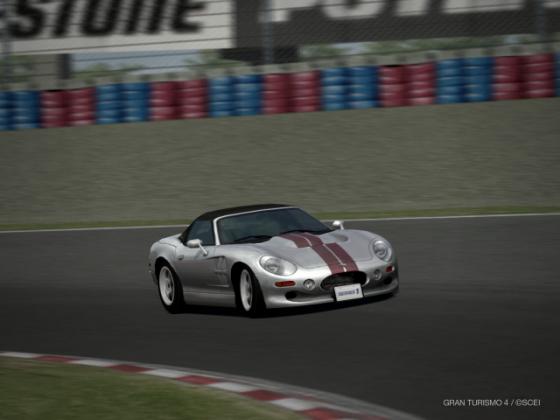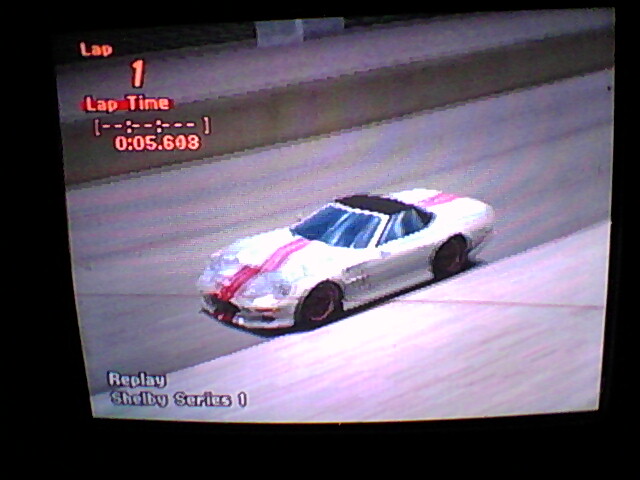|
SPEX
°°°°°°°°°°°°°°°°°°°°°°°°°°°°°°°°°°°°°°°°°°°°°°°°°°°°°°°°
Year:
1999-2003
Class: Exotic Sports Car
Type: 2-door convertible
Country: USA ````````````````````````````````````` Host: GT2, GT4, & GT5
Price: 1,000,000 (GT2), 184,630 (GT4), 182,241 (GT5 used
car lot)
GT5 Mileage: 1,617.5
Length: 168.9" Width: 76.5" Height: 47.0"
Wheelbase: 96.2"
Overhang: 6 feet 0 inches
Track: 59.4" [F] 60.4"
[R]
Ground Clearance: 5.1" (GT2), 5.0" (GT4)
Weight: 2,649 pounds
Weight Distribution: 50/50
Construction: carbon
fiber shell, aluminum frame
Layout: Front Engine / Rear Drive
Steering: power assisted rack & pinion
Turns Lock to Lock: 1.600
Tires: 265/40 ZR-18 [F] 315/40 ZR-18 [R]
F.
Suspension: rocker arms, adjustable coils, shox, anti-roll bar
R. Suspension: rocker arms, adj. coils, shox, pushrod links,
anti-roll bar
Suspension Parts: aluminum alloy
Brakes: vented discs
Engine: 244 cubic-inch DOHC V8
Construction: aluminum block & heads
Aspiration:
natural (GT2), supercharged (GT4 & 5)
Fuel System: electronic fuel injection
Valves per Cylinder: 4
Bore x Stroke:
3.43 x 3.31"
Compression: 10.3:1
GT2 Redline: 6,500 // RPM Limit: 7,000
GT4 Idle: 750 // Redline: 6,650 // RPM Limit: 7,000
GT2 Tested HP: 321 @ 6,400 rpm
GT2 Tstd Torque: 291 @ 5,000
GT4 Final BHP: 336 @ 6,500 rpms
GT4 Fnl Torque: 305
@ 5,000 GT5 Final HP: 335 @ 6,500 GT5 Fnl Torque: 304 @ 5,000
Lbs. per HP: 8.25 (GT2) // 7.88 (GT4) // 7.91
HP per Liter: 80.3 (GT2) // 84.1 (GT4) // 83.8
GT2 Credit /HP: 3,115.27
GT4 Credits /HP: 549.49 GT5 Credits / HP: 544.00
Transmission: 6-speed manual
Differential: limited-slip
``````````````````GT2````````````````````````GT4````````````````
0-60 mph: 5.0 seconds
5.183 seconds
0-100mph: 11.7 seconds 10.500 seconds
0-150 mph:
no test 24.450 seconds
400 M: 13.722 @ 109 mph 13.338 @ 114
mph
1 KM: 24.132 @ 141 mph 23.346
@ 147 mph
GT2 Test Track: 1:35.823
GT4 Test Track: 2:10.105
GT4 100-zero mph: 4.12 seconds
GT4 Top Gear RPM @60
mph: 1,500
Skidpad (real-life): 1.0 g
GT2 Top Speed at Redline:
1st: 62 mph @ 6,500 rpm
2nd: 93 mph
3rd: 129 mph
4th: 167 mph
5th:
169.70 mph @ 4,800 rpms
6th: N/T
GT4 Top Speed at Redline:
1st: 42 mph
2nd: 73 mph
3rd: 98 mph
4th: 128 mph
5th: 180.64
mph @ 6,900 rpms
6th: 175 mph @ 4,700 rpms
--------------EXTERIOR / HISTORY--------------
Shelby's Series 1 = Dodge Viper Junior.
There's a pretty good description of this racy-looking, expensive car. Basically, the Series 1 is
like a Viper, but it's lighter and has less power. Yet it isn't much slower. Oh, and in GT2, it costs $924,590 more
than a stock GTS, almost forgot that part. Did you think the Viper was expensive? What about any of the RUFs? Heh
heh heh. Oddly, in GT4 and 5 we have supercharged versions, which cost nowhere near a million. We'll get to this in a
minute.
Like the dealer says, the Series 1 is basically Shelby's creation. It's not a warmed-over Mustang
or Vette, it's his own car...his own idea. It is built with a carbon-fiber monocoque body shell (hence we have a relatively
light weight when compared to many other modern sports cars) and designed to be somewhat unique. I kinda wish there were more
color options available. Gray with maroon racing stripes just isn't cutting it for me. Neither is gray without maroon
racing stripes. That's basically the two options for body paint. In GT5 we can finally customize further here,
yet painting the car will often mute those stripes (see pictures below). At least we can finally paint it something less
drab though, right?
Now here's the thing about that price in GT2. A Series 1 in this game costs a million credits!
Okay, a visit to www.conceptcarz.com has a spec sheet for the '97 Series 1, and lists the original price as $100,000. Hmmm, seems
the folks over at PD added an extra zero somewhere. With more online searching, I actually found one of these cars for
sale on eBay, for "just" $175,000.
..Well, let's assume Polyphony Digital is right. Let's assume that wherever they did their research,
it was valid and the car really does cost a million bucks; would it be worth it?
Some things of merit: the Shelby Series 1 is only 2,649 pounds, which is about
500+ less than many typical sports cars. It is fast. Real-life testing of the car shows it gets to 60 mph in 4.4 seconds and
has a top speed of 171 mph, which is pretty close to the speed I got. Good pound to power ratio, sounds great, too. Plus,
Gran Turismo did a good job with their detailing--especially the rag-top, this goes for the lo-res version in GT2.
....But there are some cons, too. Plenty of them! If the Series 1 cost 100,000 cr, I could forgive
Shelby. But if I'm gonna fork over a million credits, that car better be worth it! GT4 Series 1's cost 184,630
cr instead of 1,000,000 cr, and GT5 is pretty close to 4. Which game is right?
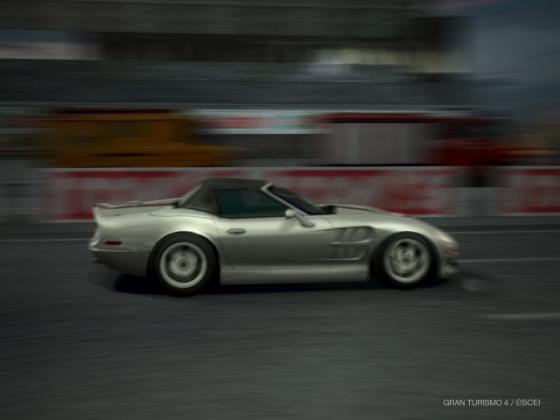
|
| blasting down the Route 5 straightaway... |
--------------ENGINE / DRIVETRAIN-------------
As mentioned before, the small-block 4 liter V8 engine sounds
and runs great. In 1999 when GT2 was released, the Shelby Series 1 was normally-aspirated, but the car in later games has
a supercharger. Despite this, in GT4 or 5 we've now got just 16 extra horses after oil change & maintenance done.
The
motor sounds fantastic, as I said; though as soon as some parts are bolted on, that grumbling, burbling growl is
replaced. Semi-racing equipment makes the car sound like a bandsaw in GT2, and the full-racing stuff makes it sound rather
like a power transformer. I don't mind, but some folks might get annoyed with it after a 2-hour enduro, for instance.
There
are three levels of power available for this machine. In GT2 or 4, Stage 3 will get up to 580
hp. HP peaks later in GT2 than it does in GT4 (7,200 rpms versus 6,500). In GT2, max power creates 432 ft-lbs.
of torque @ 6,100 rpms, yet 494.37 @ 5,000 rpms in GT4. Torque is higher in later
games perhaps due to that supercharger.
In any event, see what I mean about the ‘Viper Junior’ nickname?
At 580 hp, a real Viper is just getting warmed up. ;)
Engine balancing (GT2) won't
raise the redline, but it adds 1,000 more rpm after it. Only with Stage 2 or 3 power will the tach get 500 extra
rpm for an 8,000 rpm redline in GT2. Mostly, this is all you'll really need, especially if you're using the stock, sports,
or semi-racing transmissions. GT4, unfortunately, was modeled with a different scheme in mind. In this game, peak power is
acheived at 6,500 rpms, yet the redline is barely past this at 6,650...and the RPM limit (at 7,000) kills things too early.
There are many, many times when the S1 is stealing past some other car in 2nd gear that we won't be able
to keep it rolling as long as we should be able to, without that upshift into 3rd. Which means a little momentum often
gets lost just as the Shelby is needing to keep it comin'. I've found myself blowing it once in a while -- trying to
keep it in 2nd while smacking that limiter. This isn't a major issue for automatic-transmission users, of course.
And
here's another issue, but this time for the car in GT2: uh....the transmission. It might as well be a 4-speed, let's
face it. The car's standard gearing is dialed real tall. 4th gear will redline at 167 miles per hour, for
instance; and when shifting into 5th, the car really struggles. At this speed I was only able to squeeze 2 extra mph out of
it. 6th gear is dialed to .500, and this is matched with a 3.120 final drive. This means that the engine is revving just
1½ times for every revolution of the tires! This is SUPER-tall gearing. Even with the super-close gearbox (semi-racing)
you've still got an engine spinning at 1.72:1 with the back wheels. What does this mean? It means you'll barely need 5th gear
and never need 6th in GT2!
Get a racing gearbox. Not only will the car have a more flexible power-band, it'll
be a hell of a lot more exciting to drive. More bite out of corners, more tire smoke, too, if this is desired. 2nd and 3rd
gear suddenly come to life. I found myself selecting auto-setup 1, then raising the final drive (I never do this, usually)
just to get the car behaving more to my tastes with shorter gears.
The GT4 & 5 Series 1 "Supercharged" has
a closer stock transmission, and is a lot more useful. In these games, only 6th is dialed really tall. GameSharkers may be
able to find some use with it, perhaps, but for the rest of us 6th gear is just too tall, even for fully-modified cars.
Close and super-close gearing can also be used at smaller tracks...the car won't truely need a racing gearbox in this
game, unless the driver happens to be overly-anal.
One thing of merit is the fact that Shelby designed the Series
1 so that its transmission is somewhere behind the driver; which gives the car a better weight distribution. Because
of this layout, acceleration runs are great...this car rarely lets those back wheels get too crazy with wheelspin, and at
times the Series 1 almost behaves like a mid-engine car. The real-life Series 1 gets to 60 mph in 4.4 seconds. I could get
nowhere near this in GT2 (thanks to that tall gearbox), but in GT4 when dropping the clutch in 1st gear at 3,000 rpms with
N3 tires, the Series 1 stomps off to 60 mph in 4.566 seconds and 100 mph in 9.800...close enough to real-life testing to satisfy.
Technically, this should be wonderful, but in reality, this car's "best of both worlds" motor/tranny layout can create
some problems. Let's dig into this now.
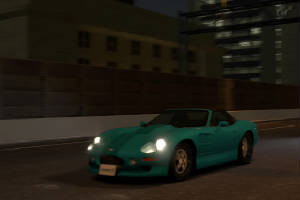
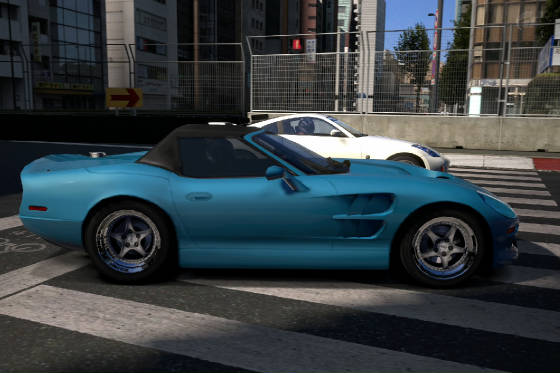
-----------------CHASSIS / HANDLING------------------
My main issue isn't with the Shelby Series 1 in GT4...it's actually
the GT2 version, and it has to do with the price in this game, as you've probably gathered by now.
For the most
part, all cars (GT2, GT4, and GT5) are strong in the maneuverability & handling departments, but they do NOT have
‘million credit’ handling by any means! The Mazda 787B, for instance, has million credit handling. At best,
the Shelby has $50,000 handling, perhaps.... somewhere between a Viper and a Honda S2000.
But there are some
good things: ground clearance is low at just 5 inches to start. The car is also wide and stable, and has plenty of groundforce,
too (which unfortunately can't be modified with a race-kit in GT2). We can see this in this game since stock aerodynamics
are set at 0.34 and 0.53. In fact, this groundforce is so effective, you'll need to be careful when following
other cars into corners at times in this game, because the car may just lose its aerodynamic edge and fly out
of bounds. Let's discuss the differences between each game further now.
GT2:
The Series 1 is just plain fun to race. But it is tempermental
at times, too. That nice 50/50 weight distribution makes the car evenly balanced, but also puts some weight towards the rear.
You'll see it, too, as soon as things get sideways, because the Series 1 just loooooves oversteer. At times, the
car fishtails so easily, you'll start to think you're at a seafood restaurant (ba-dum-tss)
But you'll notice
plenty of Corvette Grand Sport-like understeer, too, especially when exiting corners. It's not a ‘60s
muscle-car’ type of understeer, but it can be damaging to lap times, nonetheless. The oversteer is definitely
more dangerous, though. In comparison, it's easier to drift in a Viper (and a higher-powered Viper, at that) than it is in
a Series 1. It takes a bit more concentration to control the Shelby. Once the car is lined up where you want it to
go, there will be no problem kicking the accelerator down, though. The rear-mounted tranny helps alot with traction once
the car gets straightened out.
Before its engine has been modified, stock (normal) tires will be fine to race on for
many events. Challenging, but manageable. With Stage 1 power, sport tires are a better match, but the car will just barely
be controllable at times. It's like trying to balance on a fence. I raced the Series 1 in the NA-tuned race, using sport
tires to erase the car's power advantage. For the Grand Valley 300 KM enduro, I used sports again with Stage 1 tuning,
and the car was wanting to slide all over the place, so I didn't need to force drifts too often. The RUF Porsches definately
had the cornering advantage here. Understeer in a GT2 Series 1 switches to oversteer as the power gets applied. This happens
in the blink of an eye. Exciting but dangerous. I still won the GV 300KM (with 390 hp) but it was thru a bit of concentration
and skill.
Now in GT2 with Stage 2 power, slick tires will be needed--no ifs, ands, or butts. Sith Stage 3, super-soft
slicks will keep the Shelby going where you want it to go, especially if some top-notch racing is to be desired. I found
the handling pretty good once it was dialed in. Not million-credit handling, but certainly above acceptable. Use of stabilizers
seems almost optional-there isn't much body-sway even in a stock Series 1. Also, it seems Carrol Shelby's factory-installed
limited-slip differential does a wonderful job; it kicks in almost immediately. Inside-tire smoke briefly gives a little
puff before the LSD unit evens things out.
GT4 Everything above is still true
except here, the Series 1 generally has a tamer back-end that GRIPS out of corners with a precise mix of flexibility and chomp.
Sports tires, standard tires....it doesn't matter.
Maybe I'm a better driver than I was in my GT2 days, but I
never had oversteer or fishtailing become an issue with the GT4 version. A limited-slip of any kind will ruin this
excellent backside (even with full power), so I personally prefer not to use one. The Series 1 in this game exhibits good
high-speed stability, maneuvers thru esses and chicanes like a pro, and (despite my earlier criticism on price) is well worth
those credits spent in the long run, especially since it is lighter than many others.
Understeer shows up long before
oversteer ever does in GT4, and oddly gets to be a problem at times in those slower corners--presumably because downforce
is no longer keeping the car's front-end as glued as it does at higher speeds. In the rare moments that the rear would get
squirrely (usually after I drove off of a bump or grid), the Series 1 scrambles for just a second or so before its stock
limited-slip grabs in and gets you MOVING again. GT5 The fun only intensifies
in this game, since rear-drives got a more realistic set of handling profiles. The Series 1 is incredibly rare now. In
earlier games, it's been a stalwart which can easily be located at the Shelby dealer. Well no more. Now we must hunt
for our copy. And good luck with that venture. I located mine after
weeks and months, and this is a car which can compete happily in some of GT5's mid-to-latter events: Supercar Festival and
Tuning Car Grand Prix are a couple examples. It's too strong for the FR Series though, not that I'm surprised. I initially
drove my Shelby in the Tuning Car Grand Prix, which requires hard racing tires. From the car lot, this car is equipped with
hard sport tires, but what happens if we take this down a step, to a good set of radials? I was expecting something really horrible, of course. With 335 horsepower going to the rear, and 290 foot-pounds
stomping out of Grand Valley's slower areas, I was expecting quite a mess. The Series 1 isn't nearly as bad as I thought it
would be though. Remember, even though the tires are soft comforts, we've still got 265/40 ZR-18s up front with 315/40ZR-18s
pushing us around. Show a little restraint, and the car does behave. Granted, I can't go flying into every turn
like I did during the TCGP, but otherwise, the car handles well enough that it offers some merits. Understeer is light to medium, and is mostly felt during slower areas, but it's still nowhere near GT4 understeer.
But the good thing is ... everything else. This Shelby offers a front-end which grips slightly during larger, higher
speed curves, and this means lift-off oversteer becomes a reality if we need it. The Shelby offers throttlesteer of all kinds
as well: mild, medium, and wild! I am glad I waited so long to find this machine. But the truth is, things could be better. I mean, I just posted 2:18.236, which is pretty tame,
and downright unacceptable for most racing situations. The Shelby is driveable with radials in place, but it's still a situation
which requires plenty of tiptoeing. Now with the car's stock hard sport tires, mad seconds get deducted from the tally, and
my "best of three" became 2:11.667. What a huge difference. The Shelby steps up to the plate now with much
more confidence, a lot less tiptoeing. The rear-end slides deliciously like a hockey player on ice if I want this, or I can
give (let's say) half-throttle to merely make for some extra steering motions happen back there. It's like this car was designed
for track day! But there are some problems, oh yes. Braking doesn't
feel as confident as I was expecting, for one thing. It doesn't feel like I can stop this thing 'on a dime' as I did in those
previous two games. I began slowing in Grand Valley's first hairpin, for instance, starting at 100 meters. Perfectly acceptable
and doable in past games, only to find my blue-painted sports car now sliding off into some sand! Urrf. Not cool. 120
meters? Hey, I'm still on pavement, but taking a very wide line into Turn 2. It's just something unexpected, really. Make those brake distances longer, buddy, okay? Check.
But what I DIDN'T expect? Yeah, you guessed right if you guessed at all. There is still some understeer, and it still happens mostly during slower turns: both hairpins, the wide loop
between the first and second tunnel, the S-turn area just after the final tunnel are some examples. I wait for it
to go away, and it does eventually go away (after maybe a second or two), but it's that 'second or two' that'll have
many drivers eager to get some softer tires underneath, and especially up front. And
then one final demerit has nothing to do with handling; it's something which was mentioned earlier ... the awkward shift from
2nd to 3rd gear, and lack of redline area. At a track like Grand Valley, which has several sections requiring the driver
to stay in gear if he can, all of these malaises are still a reality. Good thing the engine is torque, but even with stock
power, this is something to consider. But overall, Dodge Viper Junior
still holds a candle to many others, and burns them with some unleaded premium in its wake.
Summary The theme of this review has been "is this car worth it?" and the answer
is always "Yes", in my opinion. But it depends how eager and prepared the driver is to entertain some notions: cost is
a factor in GT2, and drivability is a factor in all games, especially for those not-so-experienced. But for those ready to
try something different and Americanishly exotic, here you go.
PROS-------------------------------------------------------
1). A fast ride. Accleration and speed both come easy.
2). 259 hp extra horsepower available
with full upgrades in either GT2 or GT4. The GT4's car is supercharged, and winds up with a lot more torque than the GT2 version.
Despite this, wheelspin is not usually a problem with the GT4 car.
3). The 244 cubic-inch OHV Oldmobile Aurora V8
sounds like a V8 should. With a stock muffler, anyways...
4). ...and that powerband! Jump on those revs at
just about any time and the response is reliable. This car wants to race just as much as we do, folks.
5). Balanced
weight distribution and race-worthy stock suspension (with strong coils) guarantees a lack of body-sway, diving, and squatting,
making the Series 1 flexible and reliable to win with.
6). Most modern sports cars (especially American) weigh
over 3,000 lbs. The Series 1 clocks in at just 2,649 and can be reduced to just over 2,400 in GT2 .... 2,330 in GT4. With
such low weight, lack of power only becomes an issue in the fastest of events.
7). Stock tires have decent grip; give
the car a tendency to handle neutrally before the engine is modified. Perfect mixture of fun, frivolous, and fastidious.
8). Excellent brakes. With the controller, you can dumb the brakes down and
it'll still stop on a dime.
9). Limited-slip differential comes stock in real-life, and I think PD took this into
consideration while putting the S1 in our games. Rarely should anybody need to add something from the aftermarket
here.
CONS------------------------------------------------
1). GT2: the Series 1 oversteers too easily sometimes. It understeers like a C4 Corvette as well, meaning you'll
often have to wait for it to steer-in while losing precious tenths of seconds, as more nimble autos slip by. We can't
rely on cornering trick-maneuvers to avoid plowing in this game so much...firm braking is usually the best medicine.
2).
GT4: oversteer is largely absent, but understeer still shows up at times, especially when you wish it hadn't. GT5: oversteer
of all kinds is now much more of a factor. Easy to drive if you're expecting it, but a bear to handle if you're
not.
3). GT2: A million credits? Is Gran Turismo serious? The car in GT4 & 5 is much cheaper, yet
still on the pricey side.
4). For all this money, why can't we get some different color schemes?
5). Extremely
tall gearing in GT2. Close and super-close gearboxes don't help much. The GT4/5 car isn't as bad, but 6th is still
useless in this game.
6). The tall gearing doesn't hurt acceleration, but it makes it seem about as exciting as reading
the latest Business Journal at times. No smoke. No burnouts.... (not applicable to GT5).
7). With full weight reductions,
the Series 1 skips and fishtails alot under hard braking--though downforce helps keep the car glued to the road. Careful with
those brake-balancer settings.
8). GT2: no racing body available, which means downforce can't be modified. I
believe this car could be World Cup material if it did accept a race-kit.
9). Some of the aftermarket exhaust
upgrades sound annoying; nothing like the V8 snarl you'd expect. 10). GT5:
very hard to locate one of these in this game's used car lot. Get your detective kit out. 11). GT5 again: both outside mirrors useless unless we turn our head. Agh.. there you go. 12). Here we have a car that could possibly handle more power than full-Stage 3 tuning allows.
Oh well. Published: November 5th, 2004
Edited for GT4 content:
?
Edited for GT5 content: January 6th, 2016
|



